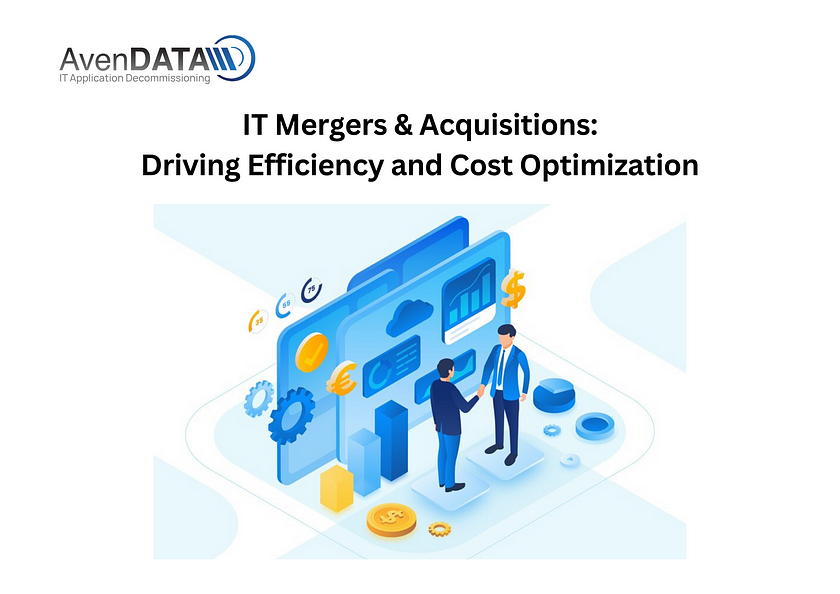IT Mergers & Acquisitions: Driving Efficiency and Cost Optimization

Introduction: In today’s competitive business landscape, organizations are constantly seeking ways to improve efficiency and optimize costs. Mergers and acquisitions (M&A) have emerged as powerful strategies to achieve these objectives, particularly in the realm of IT. This blog explores how IT M&A can drive efficiency and cost optimization, outlining key considerations, benefits, and challenges organizations face in this transformative process.
Consolidating IT Infrastructure: One of the primary drivers of efficiency and cost optimization in IT M&A is the consolidation of IT infrastructure. By merging or acquiring companies, organizations can streamline their IT operations, eliminate redundancies, and optimize resources. This consolidation enables the integration of systems, applications, and networks, resulting in improved efficiency and reduced costs.
Achieving Economies of Scale: IT M&A allows organizations to achieve economies of scale, leading to increased efficiency and cost savings. By combining resources, purchasing power, and negotiating contracts with vendors, organizations can benefit from volume discounts and more favorable terms. This scaling effect helps optimize costs across various IT functions, including software licensing, hardware procurement, and data center operations.
Standardizing Processes and Workflows: The integration of IT systems and processes during M&A provides an opportunity to standardize workflows and eliminate inefficiencies. By implementing consistent processes and best practices across the merged entities, organizations can reduce duplication, improve collaboration, and enhance operational efficiency. Standardization also facilitates better resource allocation and reduces the need for redundant IT roles and functions.
Leveraging Shared Services: IT M&A allows organizations to leverage shared services, resulting in cost optimization and improved efficiency. By centralizing common IT functions such as help desk support, infrastructure management, cybersecurity, and application development, organizations can eliminate duplication, streamline processes, and leverage specialized expertise. Shared services enable resource pooling, knowledge sharing, and overall cost reduction.
Rationalizing Application Portfolio: M&A presents an opportunity to rationalize the application portfolio, optimizing costs and improving efficiency. By assessing and consolidating software applications, organizations can eliminate redundant or underutilized systems, simplify maintenance, and reduce licensing and support costs. This rationalization allows for a leaner, more efficient application landscape that better aligns with business needs.
Optimizing Vendor Relationships: IT M&A provides organizations with an opportunity to optimize vendor relationships and contracts. By consolidating vendor portfolios, organizations can negotiate better terms, reduce costs, and improve service levels. Rationalizing vendor relationships also enables organizations to focus on strategic partnerships, leveraging the expertise and capabilities of select vendors to drive efficiency and innovation.
Challenges and Considerations: While IT M&A offers significant benefits, organizations must navigate several challenges to drive efficiency and cost optimization:
Cultural Integration: Merging different organizational cultures can pose challenges to achieving efficiency and cost optimization. Organizations must focus on fostering open communication, promoting collaboration, and aligning values and goals to ensure a smooth integration of people and processes.
Data Integration and Management: Consolidating data from different systems requires careful planning and execution. Organizations must address data integrity, quality, and compatibility issues to ensure accurate and efficient data management post-merger.
Change Management: Managing change effectively is crucial to driving efficiency and cost optimization. Clear communication, employee engagement, and comprehensive change management strategies are vital in navigating organizational transitions and minimizing disruptions.
IT Governance and Risk Management: M&A can impact IT governance and risk management frameworks. Organizations must assess and align governance structures, policies, and risk management practices to ensure compliance, mitigate risks, and drive efficiency.
Conclusion: IT Mergers and Acquisitions offer organizations a significant opportunity to drive efficiency and cost optimization in their IT operations. By consolidating IT infrastructure, achieving economies of scale, standardizing processes, leveraging shared services, rationalizing the application portfolio, and optimizing vendor relationships, organizations can streamline operations, eliminate redundancies, and reduce costs. Effective management of cultural integration, data integration, change, and IT governance challenges is crucial for successful implementation. By embracing these considerations, organizations can harness the transformative power of IT M&A to achieve enhanced efficiency, cost optimization, and sustained competitive advantage in the dynamic business landscape.
#AvenDATA #legacysystems #ITlegacysystems #ITmergers #ITAcquisitions #mergers&acquisitions #datamigration
